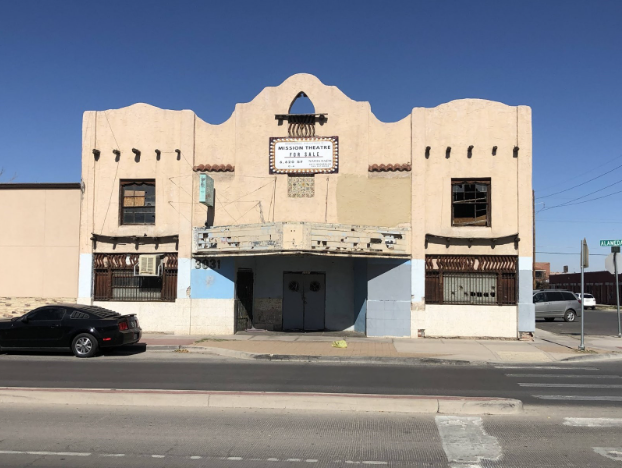By Jacobo Villegas
El Paso's South-Central neighborhood once contained a business named the Mission Theatre at 3301 Alameda Avenue. Talk of the construction of this business began appearing in local newspapers in late 1940. According to El Paso Herald-Post headlines, the new theater structure according to the drawings by architect O.H. Thorman would harmonize with the street plan of Alameda Ave.1
The main design aesthetic of the Mission Theatre had an influence reminiscent of old Spanish missions, albeit without the implementation of adobe, but rather the use of bricks and cream-colored stucco to emulate this appearance.2 One detail from the papers that brought into context the development of entertainment into different areas of the city was explained in this quote, "we believe in El Paso, and we see the need for a theater in the east side of the city."3 This just puts into perspective how the city of El Paso was developing and how what is now considered South Central was known as the East side in the 1940s. Regarding the specifications of this building, the intended amenities and staffing that were prognosticated prior to its opening included a sizeable amount of funds invested into the development of the theater. The amenities that were to be designated for the Mission Theatre included air conditioning, fluorescent lobby lighting, new arc lamps, and a Western Electric sound system that alone cost $4000.4 Calculating for inflation, that amount would total approximately $86,238.5
The opening proper of the theater seemed to be quite a spectacle for the city of El Paso. On March 15, 1941, the Mission Theatre had its grand opening. That night, the selection of films was "Here Comes the Navy" featuring James Cagney and Pat O'Brien and "The Human Monster" with Bela Lugosi. Simultaneously, the Mission Theatre's sister theater, the Crawford, located in El Paso's Downtown area at 934 Main Street, celebrated this grand opening by holding a five-day showing of "ARIZONA."6 It is important to note that among the patronage of the theater, an El Paso Herald-Post mentioned the expansion of the theater house entertainment to the East side of the city. In addition, there was also mention of the accessibility that the location had for the military personnel stationed at Fort Bliss.7
Seeing how the investment and the celebration of the Mission Theatre become a part of El Paso's East Side presents this establishment as something that would last forever. Unfortunately, the building in which the theater used to be is now vacant and deteriorating. As of 2020, according to photography and a blog post written by Mark Stone, the building is for sale.8 How things change so drastically when examining the primary sources of the past and comparing them to the realities of today!
First Image: Photograph by Mark Stone, 2020
Second Image: Newspaper article from the El Paso Herald-Post, March 15, 1941
Third Image: Newspaper article of the Alameda theater (which later became the Mission Theatre) August 25, 1917
Footnotes:
1 Betty Luther, “E.P. Theater Man To Build $45,000 Movie House On Alameda,” December 4, 1940, p. 1.
2 Luther.
3 Ibid.
4 Ibid.
5 “Inflation Rate between 1940-2023: Inflation Calculator,” $4,000 in 1940 → 2023 | Inflation Calculator, accessed April 15, 2023, https://www.in2013dollars.com/us/inflation/1940?amount=4000.
6 “Gala Opening Of New Mission Theatre Tonight,” March 15, 1941.
7 Ibid.
8 Mark Stone, “1917 Mission Theater,” sketchclub.net: The El Paso Sketch Club, 2020, https://www.sketchclub.net/p/1917-mission-theater.html.






Comentarios